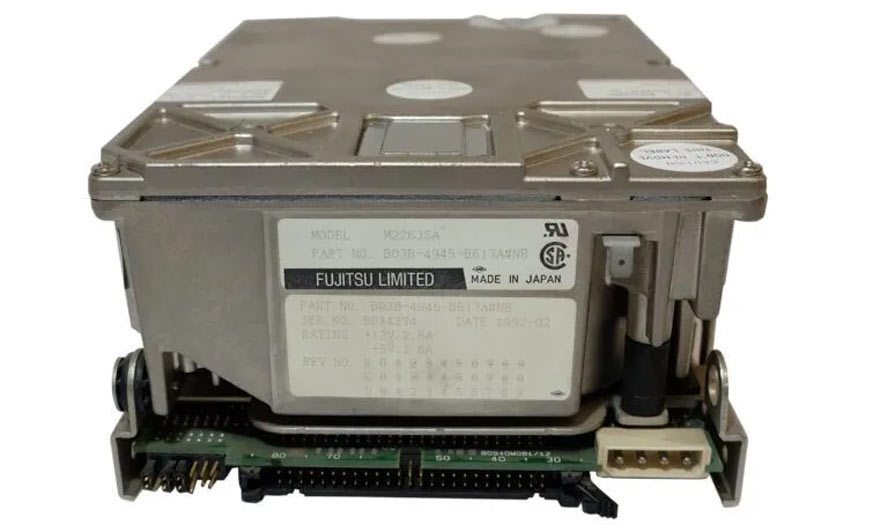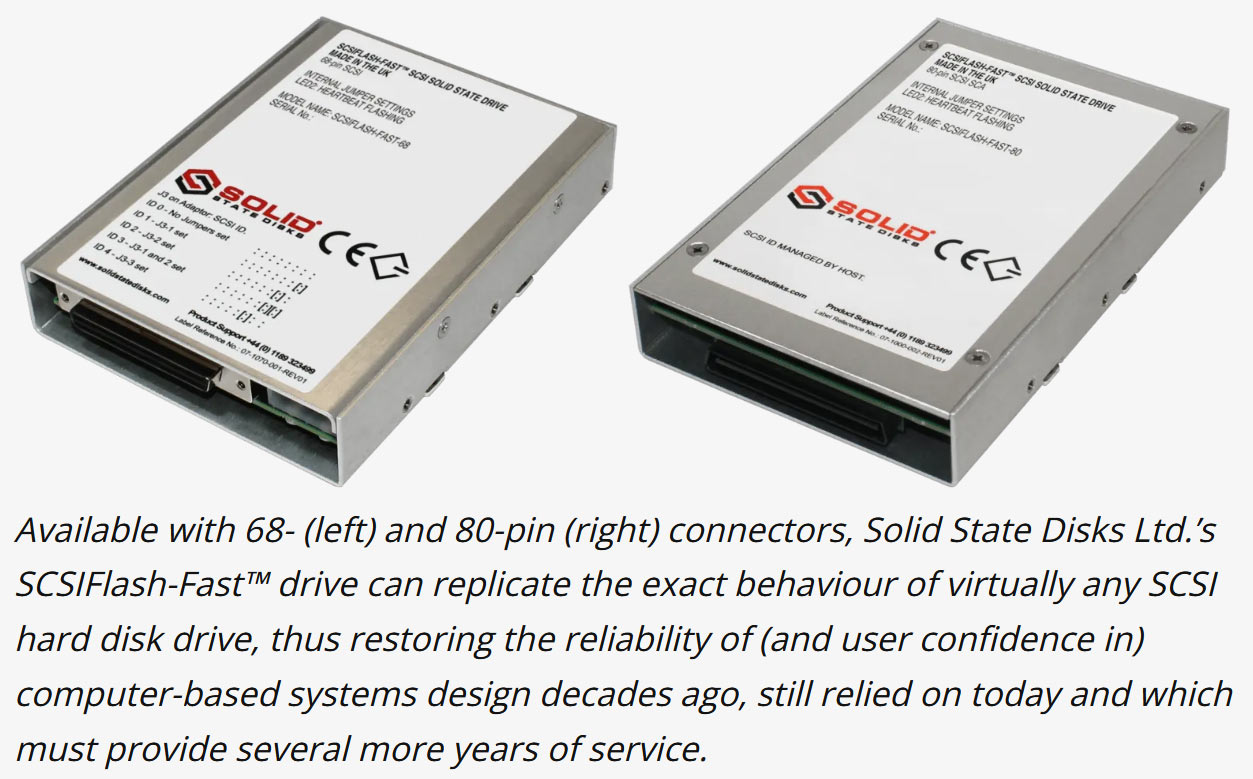SCSI isn't dead yet — new SSD for old or obsolete systems is a boon for retro computing fans
SCSIFlash-Fast uses CF or M.2 SSD cards and delivers up to 80MB/s transfer speeds.

Solid State Disks Ltd (SSDL) has released a new storage product for industries and individuals that refuse to let go of their SCSI storage-based systems. The new SCSIFlash-Fast is a 3.5-inch form factor drop-in replacement drive that can take the place of any ancient 68-pin or 80-pin connector SCSI HDD without the system even noticing. There are several touted benefits: friction-free hardware replacement, read/write speeds of up to 80 MB/s, reduced noise, reduced power consumption, a choice of Compact Flash (CF) or M.2 SSD media, and an optional Ethernet port.
Tom’s Hardware readers who are retro computing aficionados might still run old PC or Mac systems packing SCSI storage devices – just for fun. However, SSDL’s Sales & Marketing Director, James Hilken, points out that there are still systems used in aerospace, defense, manufacturing, medical, telecommunications, and other sectors “that were designed decades ago and were fitted with then state-of-the-art SCSI hard disk drives.” Hilken notes that many SCSI HDDs will be 20 years or older and, as well as being obsolete and irreplaceable like-for-like, these drives are “increasingly failing.”

SCSIFlash-Fast is configurable as a slick swap-in upgrade or replacement for that creaking SCSI drive you still rely on. SSDL says that buyers can configure to order so the newly purchased flash-based drive will “replicate the exact behavior of the SCSI HDD it replaces, meaning no modifications need to be made to the host system.” To this end, SCSIFlash-Fast can be set for SASI, SCSI-1, SCSI-2, or Ultra3 host compatibility, and disk sector sizes of 256, 512, 768, 1,024, 2,048, or 4,096 bytes.
Customers can also get their SCSI HDD data pre-loaded onto the shiny new flash-based replacement. Hilken boasts that it is possible to swap out the old HDD and insert a new SCSIFlash-Fast “and the host system will not detect the difference.” Whatever configuration you decide upon, the new system should be quieter, less power-hungry, faster, and more reliable.
Some other nice touches given to this product includes the depth of other SCSI configuration options that can be adjusted, as well as the device being firmware upgradable via USB. Last but not least, SSDL provides an optional Ethernet port that can be used for tasks like remote backups and reboots.
If you hit the link to the SSDL website you will see that the firm has a cornucopia of other SCSI-connected options such as floppy disks, magneto-opticals, tape drives, and HDDs – for 50, 68, and 80-pin SCSI connectors – with flash memory slots. Most also can be configured with Ethernet ports. Here you can see why the new SCSIFlash-Fast products got their 'Fast' suffix: their 80 MB/s performance might sound puny compared to modern storage, but the other SSDL SCSI to flash products we checked in the firm's catalog are only capable of 10 MB/s.
The SCSIFlash-Fast drives are said to be available immediately with pricing divulged upon application.
Get Tom's Hardware's best news and in-depth reviews, straight to your inbox.

Mark Tyson is a news editor at Tom's Hardware. He enjoys covering the full breadth of PC tech; from business and semiconductor design to products approaching the edge of reason.
-
TerryLaze In related news...if you want to backup an old scsi drive, now you can even without the help of an actual PC retro or otherwise.Reply
Also search for "scsi to sd" on google ebay or wherever, there have been options out there for a long time.
7EVAWWsaBUgView: https://www.youtube.com/watch?v=7EVAWWsaBUg -
Alvar "Miles" Udell ReplyHowever, SSDL’s Sales & Marketing Director, James Hilken, points out that there are still systems used in aerospace, defense, manufacturing, medical, telecommunications, and other sectors “that were designed decades ago and were fitted with then state-of-the-art SCSI hard disk drives.” .”
Just like that air gapped train we saw a little while back.
Is odd they chose to add CF capability though since an M.2 is far cheaper. -
CaptainBrowncoat Reply
CF is hot-swappable, while m.2 generally isn't.Alvar Miles Udell said:Just like that air gapped train we saw a little while back.
Is odd they chose to add CF capability though since an M.2 is far cheaper. -
bit_user I wonder if the low latency or high-throughput of a SSD could expose some bugs in software for these ancient machines. Basically, race conditions where the commands complete sooner than they used to, and therefore catch the software in a bad state. If so, it'd be funny if they had to fit these adapters with "turbo buttons" to artificially slow them down, like old PCs used to have.Reply -
Vanderlindemedia Replybit_user said:I wonder if the low latency or high-throughput of a SSD could expose some bugs in software for these ancient machines. Basically, race conditions where the commands complete sooner than they used to, and therefore catch the software in a bad state. If so, it'd be funny if they had to fit these adapters with "turbo buttons" to artificially slow them down, like old PCs used to have.
No, they would not.
There's no such thing as a timer that was needed with programs that would not use the inbuild crystal and simply relied on CPU clockspeed.
SCSI was mainly enterprise oriented - compared to ATA for consumers it offered far better options, and more reliable too. But as disks age, and likely die after years of use, getting the parts would be more difficult and expensive over time.
SSD is no holy grail too - written bytes will affect those SSD's. I'm sure with maxed out read/write speeds it could actually be beneficial for very old servers. No latency in seeking anymore. Fire it up! -
Justin Goldberg ReplyVanderlindemedia said:No, they would not.
There's no such thing as a timer that was needed with programs that would not use the inbuild crystal and simply relied on CPU clockspeed.
SCSI was mainly enterprise oriented - compared to ATA for consumers it offered far better options, and more reliable too. But as disks age, and likely die after years of use, getting the parts would be more difficult and expensive over time.
SSD is no holy grail too - written bytes will affect those SSD's. I'm sure with maxed out read/write speeds it could actually be beneficial for very old servers. No latency in seeking anymore. Fire it up!
interesting. I heard from someone that when ssd drives first came out, that many disk controllers/bios needed updates because ssds used all of the ATA or scsi commands that were not used on older technology disks. But I'm not sure if they were referring to ide or SATA drives.
Also one problem with this device is that it appears that the SSD inside is not removable, although I'm sure it can be removed.
Fun fact, ide raid cards do exist. -
bit_user Reply
About 20 years ago, a friend of mine worked for a startup that lost the RAID on one of their main servers, due to a bug in a 3Ware IDE RAID card.Justin Goldberg said:Fun fact, ide raid cards do exist.
Around the same time, I setup a server for the startup I worked at, but I avoided RAID. I wanted the simplest, most commodity setup possible, in hopes that it was the best-tested and most reliable (Linux wasn't nearly as popular, back then). So, our little source control server just had a single IDE drive and I did backups to a CD-R drive. I last saw that machine still running in a dark corner of a machine room, about 5 years ago. -
USAFRet Reply
Meanwhile, we have home users with 4x NVMe drives in RAID 0 for their game volume.bit_user said:About 20 years ago, a friend of mine worked for a startup that lost the RAID on one of their main servers, due to a bug in a 3Ware IDE RAID card.
Around the same time, I setup a server for the startup I worked at, but I avoided RAID. I wanted the simplest, most commodity setup possible, in hopes that it was the best-tested and most reliable (Linux wasn't nearly as popular, back then). So, our little source control server just had a single IDE drive and I did backups to a CD-R drive. I last saw that machine still running in a dark corner of a machine room, about 5 years ago.
And then cry when things go sideways.
